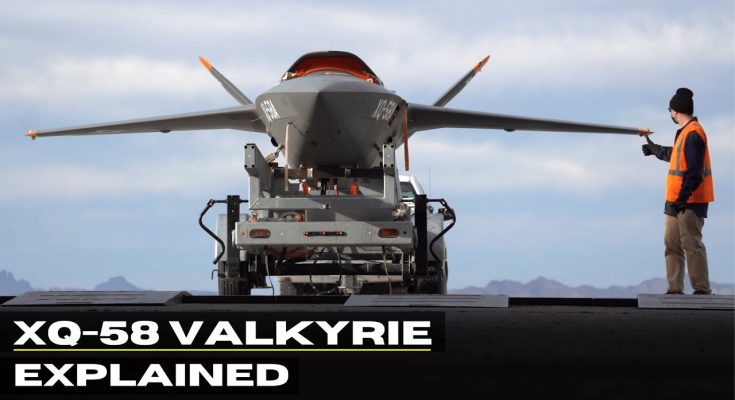The XQ-58 Valkyrie is an autonomous, high-performance drone developed by AeroVironment in collaboration with the U.S. Air Force. It is a part of the Air Force’s Low-Cost Attritable Strike Demonstrator (LCASD) program, designed to provide a cost-effective and scalable solution for expanding the U.S. military’s unmanned capabilities. The Valkyrie represents a new era of drone warfare, blending cutting-edge technology with the military’s growing reliance on unmanned aerial vehicles (UAVs). This drone could play a pivotal role in future combat, providing both offensive and defensive capabilities while dramatically altering the way modern warfare is conducted.
Design and Features
The XQ-58 Valkyrie features a sleek, stealthy design that allows it to operate in contested environments. With a wingspan of 22 feet and a length of 28 feet, the drone is small enough to be deployed from various platforms, including traditional aircraft and ground-based launchers. Its low radar cross-section (RCS) and design reduce its detectability, allowing it to penetrate air defenses undetected.
Weighing in at around 3,000 pounds, the Valkyrie is designed for long-range, high-speed missions, with the ability to travel at speeds of up to 0.85 Mach (about 650 mph) and an operational range of over 2,000 miles. This makes it highly versatile for a variety of roles, including surveillance, reconnaissance, electronic warfare, and even direct strike missions.
Autonomous Capabilities
What truly sets the XQ-58 Valkyrie apart is its autonomy. While the drone can be manually controlled, it is designed to operate with a high degree of independence, relying on artificial intelligence (AI) and advanced algorithms to make decisions during missions. The Valkyrie can adapt to changing environments and targets, potentially responding to threats faster than human-controlled aircraft.
The drone can work in tandem with piloted fighter jets, acting as a “loyal wingman” that provides support and extends the reach of combat missions. It can conduct surveillance, jam enemy communications, and even engage in combat, all while reducing the risk to human pilots. This concept of a “manned-unmanned teaming” (MUM-T) is a critical aspect of future combat, and the Valkyrie could be a game-changer in achieving this vision.
Low-Cost and High-Volume Deployment
One of the primary reasons the XQ-58 Valkyrie has generated so much interest in military circles is its low cost. The drone is designed to be an “attritable” asset, meaning it is inexpensive enough to be sacrificed in high-risk missions. With a price tag of around $3 million to $4 million per unit, the Valkyrie is a fraction of the cost of traditional fighter jets, which can cost tens of millions of dollars.
This cost-effectiveness makes the Valkyrie ideal for high-volume deployment. In future conflicts, swarming tactics involving multiple Valkyries could overwhelm enemy defenses. With the ability to field a large number of drones quickly and cheaply, the military could create drone swarms to carry out coordinated strikes or gather intelligence, complicating enemy decision-making and forcing them to respond to numerous threats simultaneously.
Versatility in Combat
The XQ-58 Valkyrie is also adaptable for various military missions. While its primary design is as a strike and reconnaissance platform, its modular payload bay allows for different configurations depending on the mission requirements. This means it could carry weapons, such as precision-guided bombs or air-to-ground missiles, or it could be equipped with electronic warfare equipment for jamming enemy radar and communications.
The drone’s ability to perform both offensive and defensive roles makes it highly versatile. It can be used to create distractions, test enemy air defenses, or serve as a platform for targeting other assets. This makes the Valkyrie an essential tool in modern military doctrine, especially as adversaries increasingly develop advanced air defense systems and countermeasures.
Future Impact
The XQ-58 Valkyrie represents the future of drone warfare and could have a significant impact on military operations. Its ability to operate autonomously, at a fraction of the cost of manned aircraft, and its potential to complement human pilots in combat scenarios gives it a distinct advantage in modern warfare. The drone could also pave the way for the development of other autonomous systems in the military, ranging from sea-based drones to ground vehicles, further transforming how the military approaches combat.
As military budgets face pressure, and as adversaries continue to develop sophisticated countermeasures, the XQ-58 Valkyrie could become the military’s next weapon of choice, providing unparalleled flexibility and efficiency in the battlefield. By providing a low-cost, high-performance alternative to traditional fighter aircraft and other platforms, the Valkyrie stands poised to be a key component of future air forces. Its combination of autonomy, versatility, and affordability could fundamentally change how wars are fought in the coming decades.



